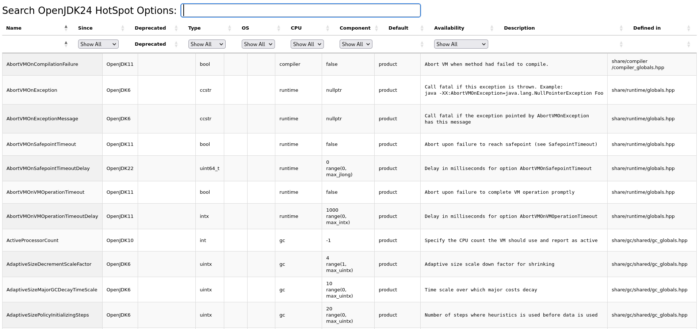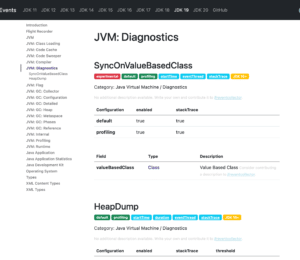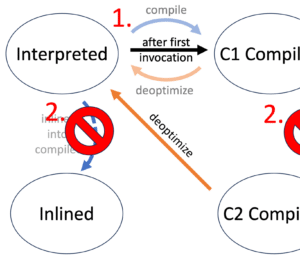Understanding JVM Memory Layout with OpenJDK24’s New PrintMemoryMapAtExit VM Option
- July 27, 2024
- 8005 Unique Views
- 8 min read
OpenJDK24 recently added a new HotSpot JVM option called PrintMemoryMapAtExit.
I know this because I'm the maintainer of a project called VMOptionsExplorer, whose job is to track changes to the more than 2000 command line options you can use to control the Java Virtual Machine (JVM).
VMOptionsExplorer presents this information as a searchable online dictionary of VM options available at https://chriswhocodes.com

and also on Foojay at https://foojay.io/command-line-arguments/ (although the Foojay copy doesn't always cover the latest JDKs).
When a new VM option becomes available it is often added to the latest development JDK (in this case JDK 24) and documentation for it is sometimes sparse.
The new PrintMemoryMapAtExit option caught my eye because my day job is related to Java performance and a deep understanding of the JVM.
A quick internet search turned up the JDK bug system ID for the development of this new option: https://bugs.openjdk.org/browse/JDK-8334026?page=com.atlassian.jira.plugin.system.issuetabpanels:comment-tabpanel
Here we can see the rationale for adding the new option:
To investigate footprint problems of processes with a short lifespan (e.g. startup footprint problems), we found it very useful to be able to get an annotated memory map at exit - the same map printed by jcmd System.map.
So the purpose of PrintMemoryMapAtExit is to provide information about the memory layout of a JVM process that might exit before you get a chance to use other tools like jcmd System.map or OS tools for reading memory layout details.
What's in the JVM's memory map?
I'll let the new option explain what information it can display.
PrintMemoryMapAtExit is a diagnostic option so we first have to tell the JVM to "unlock" the diagnostics options on the command line using the -XX:+UnlockDiagnosticVMOptions option.
-XX: options are known as non-standard JVM options (they are not part of the JVM specification). In the case of binary options they are followed by a + to enable the option or - to disable the option so to enable PrintMemoryMapAtExit you would typejava -XX:+UnlockDiagnosticVMOptions -XX:NativeMemoryTracking=summary -XX:+PrintMemoryMapAtExit -version
You'll see I added another diagnostic option -XX:NativeMemoryTracking=summary which instructs the JVM to collect statistics about it's own internal memory allocations (for a small performance overhead). This Native Memory Tracking (NMT) information enriches the output of PrintMemoryMapAtExit.
Here is the output from the new option:
Memory mappings:
from, to, vsize: address range and size
prot: protection
rss: resident set size
hugetlb: size of private hugetlb pages
pgsz: page size
notes: mapping information (detail mode only)
shrd: mapping is shared
com: mapping committed (swap space reserved)
swap: mapping partly or completely swapped out
thp: mapping uses THP
thpad: mapping is THP-madvised
nothp: mapping is forbidden to use THP
huge: mapping uses hugetlb pages
vm info: VM information (requires NMT)
CARDTBL: GC Card table
CDS: CDS archives
CLASS: Class Space
CODE: Code Heap
GC: GC support data (e.g. bitmaps)
INTERN: Internal
JAVAHEAP: Java Heap
JDK: allocated by JDK libraries other than VM
META: Metaspace nodes (non-class)
POLL: Polling pages
STACK: (known) Thread Stack
TEST: JVM internal test mappings
file: file mapped, if mapping is not anonymous
So as you might have expected, this new option will tell you where in memory the JVM kept the Java heap, thread stacks, JIT-compiled code, GC metadata, etc.
As a Java developer these JVM memory regions aren't something you usually need to be concerned about (apart from sometimes overriding the default sizes of certain regions like the heap).
Where this new JVM option might be interesting to you as a developer is if you are using memory mapped files in your application code.
Memory mapping in Java
Memory mapping is a technique for treating addressable regions that are outside the bounds of your program as being addressable from within your program.
These regions might be part of a file on disk, or they could be part of the memory space of another physical device within your system such as the frame buffer of a graphics card.
The operating system is able to manage access between your process and these external address regions. The Java core libraries provide an API for conveniently reading and writing mapped memory.
A common use of memory mapping in Java is to map a smaller region of a very large file so that you can operate on the data you want without having to read the entire file into your program's memory and write the entire file to save your changes. You can think of it as opening a small window through which you can read or write the data.
Let's assume we've created a 1GB file of random data usingdd if=/dev/random of=/tmp/bigfile bs=1G count=1
Here is a simple Java program that demonstrates reading from a large file using java.nio.channels.FileChannel and java.nio.MappedByteBuffer.
import java.nio.MappedByteBuffer;
import java.nio.channels.FileChannel;
import java.nio.file.Files;
import java.nio.file.Path;
import java.nio.file.Paths;
import java.nio.file.StandardOpenOption;
import java.util.EnumSet;
public class ReadMappedFile
{
public static void main(String[] args) throws Exception
{
Path bigFilePath = Paths.get("/tmp/bigfile");
try (FileChannel fileChannel = (FileChannel) Files.newByteChannel(
bigFilePath, EnumSet.of(StandardOpenOption.READ)))
{
// Memory map a 64KB window in the middle of the large file for reading
byte[] window = new byte[65536];
MappedByteBuffer mappedBuffer = fileChannel
.map(FileChannel.MapMode.READ_ONLY, fileChannel.size() / 2, window.length);
mappedBuffer.get(window);
// Print the data to the console
int count = 0;
for (byte b : window)
{
System.out.print(String.format("%02x", b) + " ");
if (++count % 32 == 0)
{
System.out.println();
}
}
}
}
}
Output of the program (truncated for brevity)
a3 e7 e0 ef 03 b2 92 a5 18 c9 14 d4 f9 19 5e ad bf 83 84 9b ed 18 1c 02 48 fd c2 fc 30 8d 6b 7c ce b6 5f 30 f8 73 4b 7c 80 d2 b0 51 ce 36 a9 07 85 0e 47 ef 5c 8a 2b 1a cc 2a 69 5e 25 ef 9e 9d 43 3a df 64 94 ab c7 f7 e2 46 96 51 cb da ce a9 3d 9c a5 00 30 37 b7 37 a4 24 6e 0c aa fc 2b dd af 2f 70 aa 1e 02 98 e8 cf e5 30 d1 de 35 10 97 08 19 1f bd c4 c1 7a 59 0e 1e 96 83 18 be df 8e 61 b4 0d 17 a3 75 02 13 ca 64 52 bf 59 7d 56 5d 56 09 d9 d2 1c 8b 63 43 a5 79 79 8d cd c8 80 e5 48 86 1c 6f dd eb e0 65 85 c9 92 ac 44 fd 5a 43 ad 0d b4 6d 6e 5b c7 30 e2 ad 34 0d 07 59 36 a2 b7 d3 e3 92 ae ce 6b a6 38 e5 b4 85 01 06 86 98 5b d0 a0 29 78 ff e8 ae 8e 4f e3 ec 25 12 c1 d6 73 cd ad c1 cf 17 9a 76 32 68 c8 a1 d6 2a e4 a0 b3 82 df ed df 36 6c 25 d2 78 fa 46 1e 72 b3 66
Now we know how to memory map a file in Java let's get back to the PrintMemoryMapAtExit option and see how it details our application's mapped files.
java -XX:+UnlockDiagnosticVMOptions -XX:+PrintMemoryMapAtExit -XX:NativeMemoryTracking=summary ReadMappedFile
from to vsize prot rss hugetlb pgsz notes info file ======================================================================================================================================================================== 0x0000000689400000-0x00000006a0c00000 394264576 rw-p 17076224 0 4K com JAVAHEAP - 0x00000006a0c00000-0x00000007ffc00000 5888802816 ---p 0 0 4K - JAVAHEAP - 0x00000007ffc00000-0x00000007ffd21000 1183744 rw-p 1183744 0 4K com JAVAHEAP /big/jdks/jdk24/lib/server/classes.jsa 0x00000007ffd21000-0x0000000800000000 3010560 rw-p 0 0 4K com JAVAHEAP - 0x00007f0000000000-0x00007f0000d90000 14221312 rw-p 14098432 0 4K com CDS /big/jdks/jdk24/lib/server/classes.jsa 0x00007f0000d90000-0x00007f0001000000 2555904 ---p 0 0 4K - CDS - 0x00007f0001000000-0x00007f0001010000 65536 rw-p 28672 0 4K com CLASS - 0x00007f0001010000-0x00007f0001040000 196608 ---p 0 0 4K - CLASS - 0x00007f0001040000-0x00007f0001050000 65536 rw-p 36864 0 4K com CLASS - 0x00007f0001050000-0x00007f0041000000 1073414144 ---p 0 0 4K - CLASS - 0x0000b49b739f0000-0x0000b49b739f1000 4096 r-xp 4096 0 4K com - /big/jdks/jdk24/bin/java 0x0000b49b73a01000-0x0000b49b73a02000 4096 r--p 4096 0 4K com - /big/jdks/jdk24/bin/java 0x0000b49b73a02000-0x0000b49b73a03000 4096 rw-p 4096 0 4K com - /big/jdks/jdk24/bin/java 0x0000b49ba384e000-0x0000b49ba3881000 208896 rw-p 159744 0 4K com - [heap] 0x0000ec2538000000-0x0000ec2538021000 135168 rw-p 16384 0 4K - - - 0x0000ec2538021000-0x0000ec253c000000 66973696 ---p 0 0 4K - - - 0x0000ec253c000000-0x0000ec253c021000 135168 rw-p 16384 0 4K - - - 0x0000ec253c021000-0x0000ec2540000000 66973696 ---p 0 0 4K - - - 0x0000ec2540000000-0x0000ec254029d000 2740224 rw-p 2740224 0 4K - - - 0x0000ec254029d000-0x0000ec2544000000 64368640 ---p 0 0 4K - - - 0x0000ec2544000000-0x0000ec2544021000 135168 rw-p 16384 0 4K - - - 0x0000ec2544021000-0x0000ec2548000000 66973696 ---p 0 0 4K - - - 0x0000ec2548000000-0x0000ec2548021000 135168 rw-p 4096 0 4K - - - 0x0000ec2548021000-0x0000ec254c000000 66973696 ---p 0 0 4K - - - 0x0000ec254c000000-0x0000ec254c021000 135168 rw-p 8192 0 4K - - - 0x0000ec254c021000-0x0000ec2550000000 66973696 ---p 0 0 4K - - - 0x0000ec2550000000-0x0000ec25503b1000 3870720 rw-p 3702784 0 4K - - - 0x0000ec25503b1000-0x0000ec2554000000 63238144 ---p 0 0 4K - - - 0x0000ec2554000000-0x0000ec25545e3000 6172672 rw-p 6160384 0 4K - - - 0x0000ec25545e3000-0x0000ec2558000000 60936192 ---p 0 0 4K - - - 0x0000ec2558000000-0x0000ec2558021000 135168 rw-p 4096 0 4K - - - 0x0000ec2558021000-0x0000ec255c000000 66973696 ---p 0 0 4K - - - 0x0000ec255c000000-0x0000ec255c021000 135168 rw-p 4096 0 4K - - - 0x0000ec255c021000-0x0000ec2560000000 66973696 ---p 0 0 4K - - - 0x0000ec2560000000-0x0000ec2560021000 135168 rw-p 8192 0 4K - - - 0x0000ec2560021000-0x0000ec2564000000 66973696 ---p 0 0 4K - - - 0x0000ec2564000000-0x0000ec2564021000 135168 rw-p 4096 0 4K - - - 0x0000ec2564021000-0x0000ec2568000000 66973696 ---p 0 0 4K - - - 0x0000ec2568000000-0x0000ec2568021000 135168 rw-p 73728 0 4K - - - 0x0000ec2568021000-0x0000ec256c000000 66973696 ---p 0 0 4K - - - 0x0000ec256c000000-0x0000ec256c021000 135168 rw-p 12288 0 4K - - - 0x0000ec256c021000-0x0000ec2570000000 66973696 ---p 0 0 4K - - - 0x0000ec2570000000-0x0000ec25700b0000 720896 rw-p 712704 0 4K com META - 0x0000ec25700b0000-0x0000ec2570400000 3473408 ---p 0 0 4K - META - 0x0000ec2570400000-0x0000ec2570410000 65536 rw-p 53248 0 4K com META - 0x0000ec2570410000-0x0000ec2574000000 62849024 ---p 0 0 4K - META - 0x0000ec2574000000-0x0000ec2574021000 135168 rw-p 4096 0 4K - - - 0x0000ec2574021000-0x0000ec2578000000 66973696 ---p 0 0 4K - - - 0x0000ec2578000000-0x0000ec2578021000 135168 rw-p 4096 0 4K - - - 0x0000ec2578021000-0x0000ec257c000000 66973696 ---p 0 0 4K - - - 0x0000ec257c000000-0x0000ec257c021000 135168 rw-p 4096 0 4K - - - 0x0000ec257c021000-0x0000ec2580000000 66973696 ---p 0 0 4K - - - 0x0000ec2580fbf000-0x0000ec2580fcf000 65536 ---p 0 0 4K com - - 0x0000ec2580fcf000-0x0000ec25811cd000 2088960 rw-p 12288 0 4K com STACK-1696938-GC-Thread - 0x0000ec25811cd000-0x0000ec25811dd000 65536 ---p 0 0 4K com - - 0x0000ec25811dd000-0x0000ec25813db000 2088960 rw-p 12288 0 4K com STACK-1696937-GC-Thread - 0x0000ec25813db000-0x0000ec25813eb000 65536 ---p 0 0 4K com - - 0x0000ec25813eb000-0x0000ec25815e9000 2088960 rw-p 12288 0 4K com STACK-1696936-GC-Thread - 0x0000ec25815e9000-0x0000ec25815ed000 16384 ---p 0 0 4K - - - 0x0000ec25815ed000-0x0000ec25817e7000 2072576 rw-p 32768 0 4K com - - 0x0000ec2581808000-0x0000ec258180c000 16384 ---p 0 0 4K com STACK-1696934-Common-Cleaner - 0x0000ec258180c000-0x0000ec2581a06000 2072576 rw-p 94208 0 4K com STACK-1696934-Common-Cleaner - 0x0000ec2581a06000-0x0000ec2581a0a000 16384 ---p 0 0 4K com STACK-1696933-Notification-Thread - 0x0000ec2581a0a000-0x0000ec2581c04000 2072576 rw-p 12288 0 4K com STACK-1696933-Notification-Thread - 0x0000ec2581c04000-0x0000ec2581c08000 16384 ---p 0 0 4K com STACK-1696932-C1-CompilerThread0 - 0x0000ec2581c08000-0x0000ec2581e02000 2072576 rw-p 20480 0 4K com STACK-1696932-C1-CompilerThread0 - 0x0000ec2581e02000-0x0000ec2581e06000 16384 ---p 0 0 4K com STACK-1696931-C2-CompilerThread0 - 0x0000ec2581e06000-0x0000ec2584000000 35627008 rw-p 32768 0 4K com GC - 0x0000ec2584000000-0x0000ec2584021000 135168 rw-p 4096 0 4K - - - 0x0000ec2584021000-0x0000ec2588000000 66973696 ---p 0 0 4K - - - 0x0000ec2588000000-0x0000ec2588021000 135168 rw-p 4096 0 4K - - - 0x0000ec2588021000-0x0000ec258c000000 66973696 ---p 0 0 4K - - - 0x0000ec258c000000-0x0000ec258c021000 135168 rw-p 12288 0 4K - - - 0x0000ec258c021000-0x0000ec2590000000 66973696 ---p 0 0 4K - - - 0x0000ec2590020000-0x0000ec259002c000 49152 r-xp 49152 0 4K com - /big/jdks/jdk24/lib/libnet.so 0x0000ec259002c000-0x0000ec259003b000 61440 ---p 0 0 4K com - /big/jdks/jdk24/lib/libnet.so 0x0000ec259003b000-0x0000ec259003c000 4096 r--p 4096 0 4K com - /big/jdks/jdk24/lib/libnet.so 0x0000ec259003c000-0x0000ec259003d000 4096 rw-p 4096 0 4K com - /big/jdks/jdk24/lib/libnet.so 0x0000ec2590040000-0x0000ec2590044000 16384 ---p 0 0 4K com STACK-1696930-Monitor-Deflation-Thread - 0x0000ec2590044000-0x0000ec259023e000 2072576 rw-p 12288 0 4K com STACK-1696930-Monitor-Deflation-Thread - 0x0000ec259023e000-0x0000ec2590242000 16384 ---p 0 0 4K com STACK-1696929-Service-Thread - 0x0000ec2590242000-0x0000ec259043c000 2072576 rw-p 12288 0 4K com STACK-1696929-Service-Thread - 0x0000ec259043c000-0x0000ec2590440000 16384 ---p 0 0 4K com STACK-1696928-Signal-Dispatcher - 0x0000ec2590440000-0x0000ec259063a000 2072576 rw-p 12288 0 4K com STACK-1696928-Signal-Dispatcher - 0x0000ec259063a000-0x0000ec259063e000 16384 ---p 0 0 4K com STACK-1696927-Finalizer - 0x0000ec259063e000-0x0000ec2590838000 2072576 rw-p 90112 0 4K com STACK-1696927-Finalizer - 0x0000ec2590838000-0x0000ec259083c000 16384 ---p 0 0 4K com STACK-1696926-Reference-Handler - 0x0000ec259083c000-0x0000ec2590a36000 2072576 rw-p 94208 0 4K com STACK-1696926-Reference-Handler - 0x0000ec2590a36000-0x0000ec2590a46000 65536 ---p 0 0 4K com - - 0x0000ec2590a46000-0x0000ec2590c44000 2088960 rw-p 16384 0 4K com STACK-1696925-VM-Thread - 0x0000ec2590c44000-0x0000ec2590c54000 65536 ---p 0 0 4K com - - 0x0000ec2590c54000-0x0000ec2590e52000 2088960 rw-p 12288 0 4K com - - 0x0000ec2590e52000-0x0000ec2590e62000 65536 ---p 0 0 4K com - - 0x0000ec2590e62000-0x0000ec2591060000 2088960 rw-p 12288 0 4K com - - 0x0000ec2591060000-0x0000ec2591070000 65536 ---p 0 0 4K com - - 0x0000ec2591070000-0x0000ec2591470000 4194304 rw-p 28672 0 4K com - - 0x0000ec2591470000-0x0000ec2591480000 65536 ---p 0 0 4K com - - 0x0000ec2591480000-0x0000ec259167e000 2088960 rw-p 12288 0 4K com STACK-1696921-GC-Thread - 0x0000ec259167e000-0x0000ec259168e000 65536 ---p 0 0 4K com - - 0x0000ec259168e000-0x0000ec259188c000 2088960 rw-p 12288 0 4K com - - 0x0000ec259188c000-0x0000ec259189c000 65536 ---p 0 0 4K com - - 0x0000ec259189c000-0x0000ec259207a000 8249344 rw-p 12288 0 4K com STACK-1696919-GC-Thread,GC - 0x0000ec259207a000-0x0000ec259783a000 92012544 ---p 0 0 4K - GC - 0x0000ec259783a000-0x0000ec2597906000 835584 rw-p 770048 0 4K com GC - 0x0000ec2597906000-0x0000ec25983fe000 11501568 ---p 0 0 4K - GC - 0x0000ec25983fe000-0x0000ec2598400000 8192 rw-p 8192 0 4K com GC - 0x0000ec2598400000-0x0000ec2598670000 2555904 rwxp 651264 0 4K com CODE - 0x0000ec2598670000-0x0000ec259f937000 120352768 ---p 0 0 4K - CODE - 0x0000ec259f937000-0x0000ec259fba7000 2555904 rwxp 626688 0 4K com CODE - 0x0000ec259fba7000-0x0000ec259fec7000 3276800 ---p 0 0 4K - CODE - 0x0000ec259fec7000-0x0000ec25a0137000 2555904 rwxp 237568 0 4K com CODE - 0x0000ec25a0137000-0x0000ec25a7400000 120360960 ---p 0 0 4K - CODE - 0x0000ec25a7400000-0x0000ec25afe3e000 144957440 r--s 1114112 0 4K com - /big/jdks/jdk24/lib/modules 0x0000ec25afe40000-0x0000ec25afe50000 65536 r--s 65536 0 4K com - /tmp/bigfile
In the final line you can see the 64KB window of the 1GB file mapped into the JVM's memory layout.
If you are dealing with a lot of memory mapped files then you may find the new -XX:+PrintMemoryMapAtExit option a useful addition to your diagnostic toolkit.
If you want to see exactly which options are added and removed in each JDK then visit https://chriswhocodes.com/hotspot_option_differences.html
Don’t Forget to Share This Post!











Comments (1)
Java Weekly, Issue 553 | Baeldung
1 year ago[…] >> Understanding JVM Memory Layout with OpenJDK24’s New PrintMemoryMapAtExit VM Option [foojay.io] […]